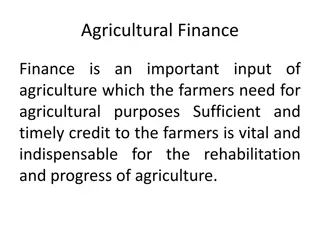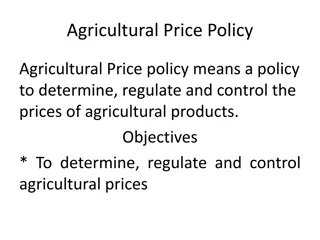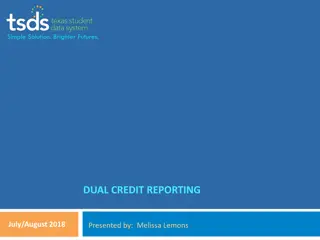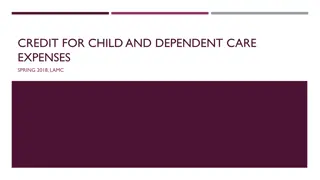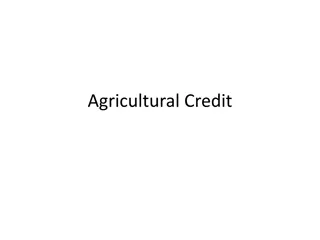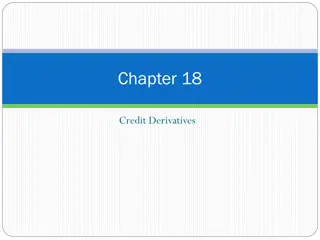Understanding Agricultural Credit: Definition, Need, and Classification
Agricultural credit involves obtaining money for farming activities with a promise to repay in the future. It plays a crucial role in facilitating agricultural production by providing financial resources from external sources. The definition, need, and classification of agricultural credit are explored in detail, covering aspects such as purpose, time of repayment, security, and more, to understand its significance in promoting economic development in the agricultural sector.
Download Presentation

Please find below an Image/Link to download the presentation.
The content on the website is provided AS IS for your information and personal use only. It may not be sold, licensed, or shared on other websites without obtaining consent from the author. Download presentation by click this link. If you encounter any issues during the download, it is possible that the publisher has removed the file from their server.
E N D
Presentation Transcript
UNIT - 4 AGRICULTURE CREDIT
AGRICULTURAL CREDIT-MEANING, DEFINITION, NEED AND CLASSIFICATION Definition Credit is obtaining control over the use of money at the present time in exchange for a promise to repay it at some future time. Credit is also defined as a device for facilitating the temporary transfer of purchasing power from those who have surpluses of it to those who are in need of it. Thus, credit involves a temporary transfer of wealth. Agricultural Credit is the amount of investment funds made available for agricultural production from resources outside the farm sector. Agricultural Finance is considered as separate field of study dealing with lending and borrowing by organizations and farmers. Hopkin et al referred agricultural finance as the means of acquiring and control of assets, ownership by cash purchase or borrowing or leasing or custom-hiring. Warren F.Lee et al defined Agricultural Finance as the economic study of the acquisition and use of capital in agriculture. It deals with the supply of and demand for funds in the agricul- tural sector of an economy. According to William G. Murray, agricultural finance is the economic study of borrowing of funds by farmers; of the organization and operation of farm lending agencies; and of society's interest in credit for agriculture. Farm Finance is a branch of agricultural economics which deals with the provision and management of services of financial resources related to the individual farm units. Farm finance can also be defined as the amount of funds obtained from off-farm sources for use on the farm, repayable in future with an interest agreed to either explicitly or implicitly. Farm Finance i. is not meant merely for more production but also to raise the productivity of farm resources; ii. not a mere loan or advance , but it is an instrument to promote the well being of the farming community; is not just a science to manage the money, but is an applied science of allocating iii. scarce resources to derive optimum output; and iv. not a mere social obligation on the society; but it is a lever with backward and forward linkages to the economic development both at toe micro and macro level.
At macro level, farm finance may be defined as the study of impact of finance (extended to the farmers by the intermediaries) on agricultural sector and also on the economy as a whole. At micro level, farm finance may be defined as the study of these intermediaries who extend finance to the farming sector and obtain their loanable funds from financial markets. Thus, farm finance should have the following features: i. ii. finance should be extended to farmers for farm activities; finance should stimulate tie productivities of farm resources resulting in higher economic returns for the investment; iii. iv. finance should promote economic development of farm households; and finance should be provided by an external agency for strengthening the backward and forward linkages with country's economic development. Further, farmers and bankers view farm finance in different ways as detailed below: Farmers Lending Agencies i) acquire finance for farm needs at extend finance which can be easily proper time. collected. ii) try to get finance at a reasonable cost try to get a reasonable rate of return for capital. iii) ensure that their own assets arenot ensure proner degree of liquidity of exposed to high risks. securities for safety. Classification of Agricultural credit Agricultural credit can be classifified based on purpose, time (repayment period), security, generation of surplus funds, creditor and number of activities for which credit is provided. i) Purpose: Based on the purpose for which loan is granted, agricultural credit is categorized into: a) Development credit or Investment Credit: This is provided for acquiring durable assets or for improving the existing assets. Under this, credit is extended for: - purchase of land and land reclamation. - purchase of farm machineries and implements - development of irrigation facilities - construction of farm structures - development of plantation and orchards
- develonment of dairy, poultry, sheep/goat, fisheries, sericulture, etc. b)Production credit: is given for crop, production: Here, the loan amount is used for purchasing inputs and for paying wages. c) Marketing credit: It is essential to carry out the marketing functions and to get higher prices for the produce. d) Consumption credit: It is the credit required by the farmer to meet his family expenses. ii) Repayment Period: Based on the period for which the borrower require credit, it is divided into: a) Short-Term Credit: It is given to farmers for periods ranging from 6 to 18 months and is primarily meant to meet cultivation expenses viz., purchase of seed, fertilizer, pesticides and payment of wages to labourers. It serves as the working capital to operate the farm efficiently and is expected to be repaid at the time of harvesting / marketing of crops. It. should be repaid in one instalment. b) Medium-Term Credit: Repayment is for the period of 2 to 5 years, It is for the purchase of pump-sets, farm machineries and implements, bullocks, dairy animals and to carry out minor improvement in the farm. It can be repaid either in half yearly or annual installments. c)Long-Term Credit: It is advanced for periods more than 5 years and extends even unto twenty five years against mortagage of immovable property for undertaking development works viz., sinking wells, purchase of tractor, and rnaking permanent improverments in the farm. It has to be repaid in half-yearly or annual instalments. iii) Secutirty: Credit is provided to farmers based on the security offered by them. a) Farm Mortgage Credit: It is secured against mortgage of land. b)Collateral Credit or Chattel Credit: It is given against the security of livestock, crop or warehouse receipt. c) Personal Credit: It is given based on the character and repaying capacity of the person and not on any tangible assets. In general, LT credit is usually advanced against security of land while MT and ST loans are sanctioned against personal and. collateral security. iv) Generation of Surplus Funds: Based on generation of surplus funds, credit can be classified as self-liquidating and non-self -liquidating credit. a) Self Liquidating Credit: In this case, loan amount gets absorbed in the production process- in one year or production period and the additional income generated is sufficient to repay the entire loan amount.
b) Non-Self Liquidating Credit: Here the resources acquired with the borrowed funds are not consumed in the production process during the project period. The investment is spread over a period of several years. The additional income generated in one year is not sufficient to repay the entire loan amount and hence the repayment is spread over to number of years. v) Creditor or Lender wise Credit: Credit can be classified from the point of view of creditor. a)Non - Institutional Agencies: They include money lenders, traders, commission agents, friends and relatives. This kind of loan is generally exploitative. b)Institutional Agencies: They include co-operative s, commercial bank and regional rural bank. vi) Number of Activities Served: Based on the number of activities for which amount the loan can be used, credit can be categorized into a) single purpose loan and b) composite loan.
Problems of Agricultural Credit in India with Suggested Remedies! Agricultural Credit: An average Indian farmer, who has to work on an uneconomic holding , using traditional methods of cultivation and being exposed to the risks of a poor agricultural season is almost always in debt. He is a perennial debtor. Once the farmer falls into debt due to crop failure or low prices of crops or malpractices of moneylenders he can never come out of it. In fact, large part of the liabilities of farmers is ancestral debt . Thus, along with his landed property, he passes on his debt to the next generation. There are four main causes of rural indebtedness in India: (i) low earning power of the borrower, (ii) use of loan for unproductive purposes, (iii)very high rate of interest charged by the village moneylender and (iv) the manipulation of accounts by the lenders. In a few cases, the bad habits of the farmers (such as gambling, drinking, etc.) are responsible for his burden of unproductive debt. However, in most cases, the cause of the debt may be some expensive social ceremony which the farmer was perhaps forced to arrange for fear of a social boycott . Need for Finance: Finance is required by farmers not only for the production and marketing of crops but also to keep a stagnant agricultural economy alive. Most Indian farmers live near the brink of starvation. A bad monsoon, a poor harvest, an accident or illness in the family forces him to approach the moneylender for a loan. In India, there is the preponderance of such distress or unproductive loans. Agricultural finance in India is not just one requirement of the agricultural business but a symptom of the distress prevailing among the majority of the farmers.
Rural credit includes not only credit provided to farmers but also credit extended to artisans, owners of small and medium industries in rural areas, small transport operators and so on. Two main sources of rural credit are private and institutional. The former includes private moneylenders, traders and commission agencies, relatives and- landlords. The sources of institutional credit are rural co-operatives, commercial banks, particularly the State Bank of India (SBI). And, with the setting up of a specialised institution called the National Bank for Agricultural and Rural Development (NABARD) the Agricultural Refinance and Development Corporation (ARDC) has ceased to exist. Up to 1982 it was responsible for extending agricultural finance under guidance of the Reserve Bank of India. It may also be noted that the short- and medium-term credit requirements of the farmers is met by indigenous bankers or village moneylenders, co-operative credit societies and commercial banks. Long-term credit needs are met by land development banks and NABARD. The principal aim of institutional credit is to replace the widely prevalent money-lending at a very high rate of interest. Available data show that the rural credit institutions have succeeded to a considerable extent in achieving this aim. Institutional Farm Finance: The need for institutional credit has been felt because of the inherent defects of private agencies. Five main defects of the system of private credit are the following: 1.It is highly exploitative in character because of the inherent profit motive. 2.Since such credit is provided largely for unproductive purposes the rate of interest charged is very high. 3.Such credit is not necessarily directed toward needy persons or desired channels.
4.Such credit is provided for short periods of time and at high rates of interest and cannot, therefore, be utilised for land development or long- term improvement of agriculture. 5.Institutional credit is not linked with other non-farm services such as marketing and processing and warehousing. By contrast, institutional credit is basically un-exploitive in character. It is largely directed towards raising agricultural productivity so that the income of the farmer increases sufficiently and he becomes self-sufficient. The rate of interest is not only low but varies from case to case. Different rates of interest are charged for different types of loans and different categories of farmers. Institutional agencies also draw a clear-cut distinction between short-term credit and long- term credit. Moreover, they recognise the organic link between credit and other needs of the farmers and seek to achieve an integration of credit with such needs. Farmers not only need credit but also guidance in adopting improved methods of cultivation. Thus, it is necessary to provide such guidance and extension services along with credit. They must be taught how to use quality seeds, fertilisers, pesticides, etc. and also how to grow crops. They must also be provided marketing assistance so that they can obtain the best possible return from their produce. Only institutions like co-operative societies, commercial banks, etc. can provide such guidance, not the usurious moneylenders and greedy commission agents. So it is now necessary to make a brief review of different institutional agencies of rural credit. Consequences: Rural indebtedness is also likely to have some undesirable social consequences. Due to ever-growing debt there emerges in the rural economy of India a class of landless labourers and tenants. Consequently independent or self-sufficient farmers gradually lose their identity. The landless workers have nothing to offer as security
in order to obtain loans from moneylenders, except their labour power. Consequently, they become bonded labourers. This creates discontent among them and adds to rural tensions. In fact, the acquisition of land by the traders and moneylenders and the con- sequent deprivation of the poor farmers of their meager landed property was the root cause of the Naxalite movement, which assumed serious proportions in West Bengal, Orissa and Andhra Pradesh in the late 1960s and the 1970s. Thus there is no use denying the problem of rural indebtedness. Sooner the problem is removed from its roots the better for India s rural economy. Suggested Remedies: Since the problem of rural indebtedness has two major dimensions, to solve the problem we have to adopt a two-fold strategy. Since the magnitude of debt is quite high, steps may be taken to cancel old debts. There is a strong case for reduction of ancestral debt and even for their liquidation. This can be done by State Governments by passing Insolvency Acts. It may be noted that the Government decided in 1990 to write off Rs. 14,000 crores of loans outstanding from farmers Up to a maximum of Rs. 10,000 crores. This was considered necessary because 80% of India s population were farmers and farm workers. Earlier in some States moratorium had been declared on the recovery of debt by moneylenders from farmers, rural artisans and landless workers as per the 20- point Programme. Secondly, it is to be ensured that the quantum of fresh borrowing is reduced to the minimum, keeping in view the repayment capacity of farmers. It is equally important to ensure that new borrowing is strictly for productive purposes and not for meeting consumption needs. It is, however, difficult for the Government to ensure this in practice. Only through the spread of education and propaganda among farmers it is possible to check the volume of loans made for
unproductive purposes. However, in LDCs like India, arrangement may also be made for providing such loans on a modest scale. As a subsidiary measure, control of the activities of moneylenders is also necessary. This has been done by some States where sale of land to moneylenders has been prohibited by law. It is important to note that the abolition of bonded labour and liquidation of rural indebtedness are the two major aspects of the 20-point Programme. The system of bonded labour was abolished by an Act of Parliament in 1976. However, it seemed that the only answer to the present multi- agency credit system is implementing a new multipurpose system with efficient management. This will have to be so devised as to meet the need for consumption loan of the farmers so that they are not exploited by being paid low wages or low returns on their products. Moreover, the RRBs, if properly managed, can go a long way in solving the problem of rural indebtedness in an effective manner. Conclusion: Due to extension of institutional credit facilities since 1950-51 the monopoly position of the village moneylender has been challenged. Due to progressive institutionalization of credit, private sources now meet barely 20% of the short- and medium-term credit needs of the farmers. In other words, institutional sources meet about 80% of such needs. But the Agricultural Credit Review Committee headed by Prof. A. M. Khusro, in its report submitted on August 1989, commented that despite the disappearance of dual financial system, moneylenders are still operating their business in rural India. One recent study of the Reserve Bank of India admitted that rural households still rely on informal credit markets for 60 to 70% of their credit needs even though interest rates charged are typically over 30%. This is due to apathy of State-owned commercial banks in providing credit to poor peasants. Actually, big landlords are
capable of obtaining more loans and advances from various institutions in their own favour at the expense of the poor farmers. Despite huge increase in overall agricultural credit, there is a serious problem of over-dues which has been inhibiting credit expansion on the one hand and economic viability of the lending institutions, mainly the co-operatives and regional rural banks on the other. The waiver of agricultural loans to the tune of Rs. 10,000 crores in 1990-91 has virtually stopped the credit cycle. If this .prac- tice is continued in the future too rural credit expansion will take a back seat. But, if more and more emphasis is to be given to the agricultural sector, lending institutions will be under more and more pressure. Above all, small and marginal farmers still remain unworthy borrowers in the banking parlance, though it was hoped at the time of nationalisation that these banks would take care of the credit needs of the farmers. Their dependence on informal markets after 50 years of planning does not augur well. The quantitative expansion of institutional sources hide all these facts. From the qualitative angle, their performance is subject to serious scrutiny.






